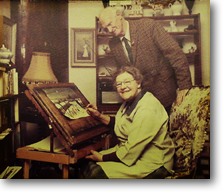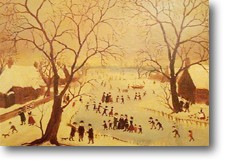
![]()

![]()

Helen
Bradley at art school c.1913.

With
husband Tom

'Afternoon
On Ice'
- after the style of Hendrick Avercamp.
![]()
elen Bradley was one of the great storytellers of the 20th century. Perhaps the most intriguing story however, is that of her own sudden and belated rise to fame in her mid-60s.
Born in Lees near Oldham in 1900, Helen only began to paint her distinctive scenes of an Edwardian girlhood at the age of 65. At first she simply wanted to show her grandchildren how different a place the world used to be when she was a child. From 1965 until her death in 1979, Helen achieved international celebrity. In the 70s she was the darling of the chat shows, appearing on Pebble Mill at One, Desert Island Discs and the Russell Harty chat show. The BBC and the American NBC network made documentaries of her life, the Northern Ballet adapted her work for the stage and shortly before her death she was awarded the MBE. Today Helen's paintings are as popular as ever. Prices for her work doubled during the 1990s and now look set to follow the astronomical amounts paid for Lowry's work.
Like Lowry, Helen Bradley has often been described as a 'naive' or 'primitive' artist. In fact she began her art education at the age of 13, winning the John Platt scholarship to Oldham Art School in 1913. The outbreak of war and parental opposition brought an early end to her ambitions. She married the painter and textile designer Thomas Bradley in 1926 and devoted the next forty years of her life to her family.
Helen never entirely lost the impulse to paint and, when living in London, made frequent trips to the British Museum. She was inspired by an exhibition of early Chinese painting and by the collection of Persian miniatures. In the 1960s she met L. S. Lowry who encouraged her in the creation of a narrative style based on her childhood memories and a personally expressive style finally began to emerge.
At first Helen focused on the period 1904 to around 1908, invariably writing a short narrative account based on memory and then illustrating the text in her immediately recognisable style. The earliest pictures usually feature Helen herself and her young brother George, her mother and Helen's three maiden aunts, family friend Miss Carter (who wore pink) and the eligible bachelor Mr. Taylor, the bank manager. They are often pictured holidaying in Blackpool, walking in Salford's Peel Park or shopping in Oldham.
The stylisation of Helen's figures is perfectly adapted to its narrative function. Richly coloured and two dimensional, their decorative appearance can be traced back to Helen's interest in Mogul and Persian miniatures. "All these people painted a story...The Turks also painted stories, about a kind of super-giant, and simplified their art. They painted horses which had generals on them very big, and all of the men very little, which absolutely tickled me pink". Helen's skies are strongly coloured and atmospheric reflecting an interest in the Dutch landscape painter Hendrick Avercamp (1585-1634). Much of the fine detailing such as brickwork and foliage was scratched though the paint surface with the end of the paintbrush. The Chinese artist Kao Chi-p'ei inspired this calligraphic approach to landscape and indeed, the very personal quality of Helen's mark making resulted from the use of her fingers, a bread knife and fish slice, as well as more conventional brushes, to manipulate the paint.
Helen's later works have a more dream-like, even fantastical, quality, often recounting the Bible stories told to her as a child by Great Aunt Jane "...she used to tell us about the flood, and how if it ever came to Lees we'd have to overturn the kitchen table and float away on that. She also said God had a shed near Oldham where He made the stars".
These stories and the adventures of Miss Carter (who wore pink) became familiar to a worldwide audience as pictures and text were published in America, Japan and throughout Europe. Miss Carter Publications published her work still further with limited edition prints and reproductions. Today Helen's evocation of an idyllic Edwardian age remains as endearing and arresting as ever.
Stephen Whittle Curator, Blackburn Museum & Art Gallery